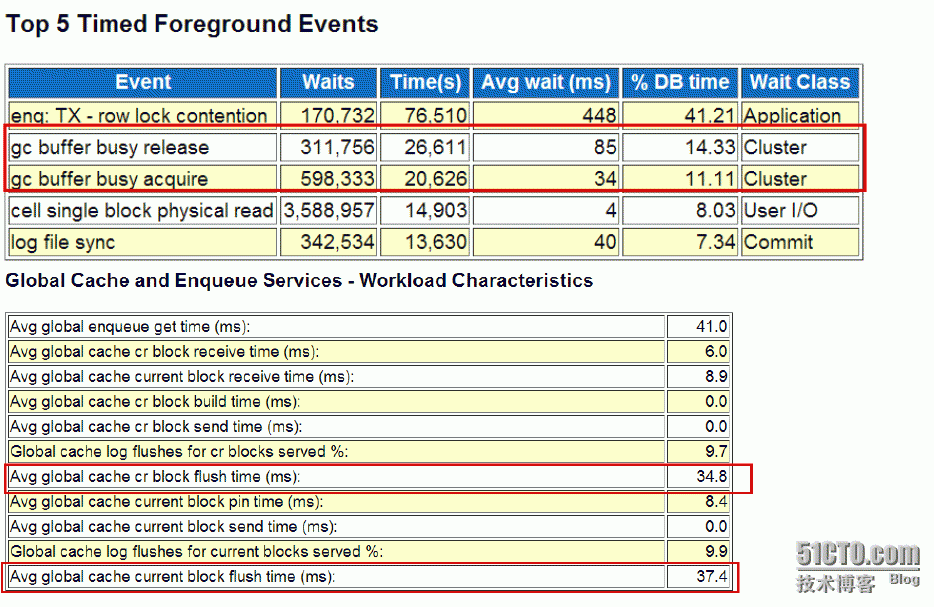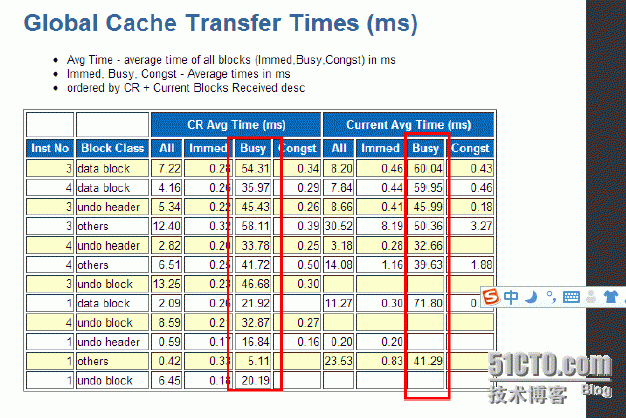GC Buffer Busy等待事件
来源:互联网 发布:口碑好的多肉淘宝 编辑:程序博客网 时间:2024/04/29 07:25
一、原理
gc buffer busy acquire/release 往往是 gc current block busy的衍生产品, 当同一实例内的多个进程并发地访问同一个数据块时 ,首先发起的进程 将进入 gc current block busy的等待 ,而在 buffer waiter list 上的后续进程 会陷入gc buffer busy acquire/release 等待(A user on the same instance has started a remote operation on thesame resource and the request has not completed yet or the block was requestedby another node and the block has not been released by the local instance whenthe new local access was made), 这里存在一个排队效应, 即 gc current block busy是缓慢的,那么在 排队的gc buffer busy acquire/release就会更慢:
Pin time = (timeto read the block into cache) + (time to modify/process the buffer)
Busy time =(average pin time) * (number of interested users waiting ahead of me)
不局限于current block (reference AWR Avg global cache current block flush time(ms)), cr block(Avg global cache cr block flush time (ms)) 也存在flush time。
可以通过设置_cr_server_log_flush to false(LMSare/is waiting for LGWR to flush the pending redo during CR fabrication.Without going too much in to details, you can turn off the behaviourby setting _cr_server_log_flush to false.) 来禁止crserver flush redo log,但是该参数对于current block的flush time无效, 也强烈不推荐使用。
二、案例1

1.RAC负载均衡下并发insert很容易造成gc buffer busy acquire。
2.本实例第一个申请该current block时进入gc current request,本实例后续其他进程若又发起对该current block的申请则均进入’gc buffer busy acquire’等待。
3.11g后gc buffer busy分成 ’gc buffer busy acquire’ 和 ’gc buffer busy release。

三、案例2

1.从上面例子可以看出Redo flush慢造成的gc buffer busy release/acquire
2.flush time 是Oracle为了保证Instance Recovery实例恢复机制,而要求每一个current block在本地节点local instance被修改后(modify/update) 必须要将该current block相关的redo 写入到logfile 后(要求LGWR必须完成写入后才能返回),才能由LMS进程传输给其他节点使用。

1.一般Flushes要小于5ms。

1.busy指标都比较高
本文出自 “无双城” 博客,请务必保留此出处http://929044991.blog.51cto.com/1758347/1264077
- gc buffer busy等待事件
- GC Buffer Busy等待事件
- RAC性能分析gc buffer busy acquire 等待事件
- RAC gc buffer busy 等待事件简单说明(转)
- 等待事件 - buffer busy waits
- 等待事件buffer busy waits
- buffer busy waits等待事件
- 找到RAC中导致gc buffer busy等待事件的热点块
- 【Oracle数据库技术支持】RAC性能分析 - gc buffer busy acquire 等待事件
- 模拟buffer busy waits等待事件
- buffer busy waits等待事件案例-vage
- gc buffer busy acquire
- oracle 重要的等待事件--buffer busy waits
- 模拟产生CBC LATCH与buffer busy wait等待事件
- rac 碰到 gc buffer busy
- Oracle RAC 全局等待事件 gc current block busy 和 gc cr multi block request 说明
- Oracle RAC 全局等待事件 gc current block busy 和 gc cr multi block request 说明
- Oracle RAC 全局等待事件 gc current block busy 和 gc cr multi block request 说明
- find Literal SQL
- Oracle常见Top Event
- Oracle CPU负载
- RAC性能综述
- GC Blocks Lost等待事件
- GC Buffer Busy等待事件
- Oracle优化器和直方图
- 万维网,互联网,因特网之间的区别
- RAC apply patch to 11.2.0.3.7
- Screen width、height、availWidth、availHeight属性
- Oracle GoldenGate
- Data Guard Broker配置篇
- 非默认监听注册问题
- python开发 Mysqldb安装及基本操作


